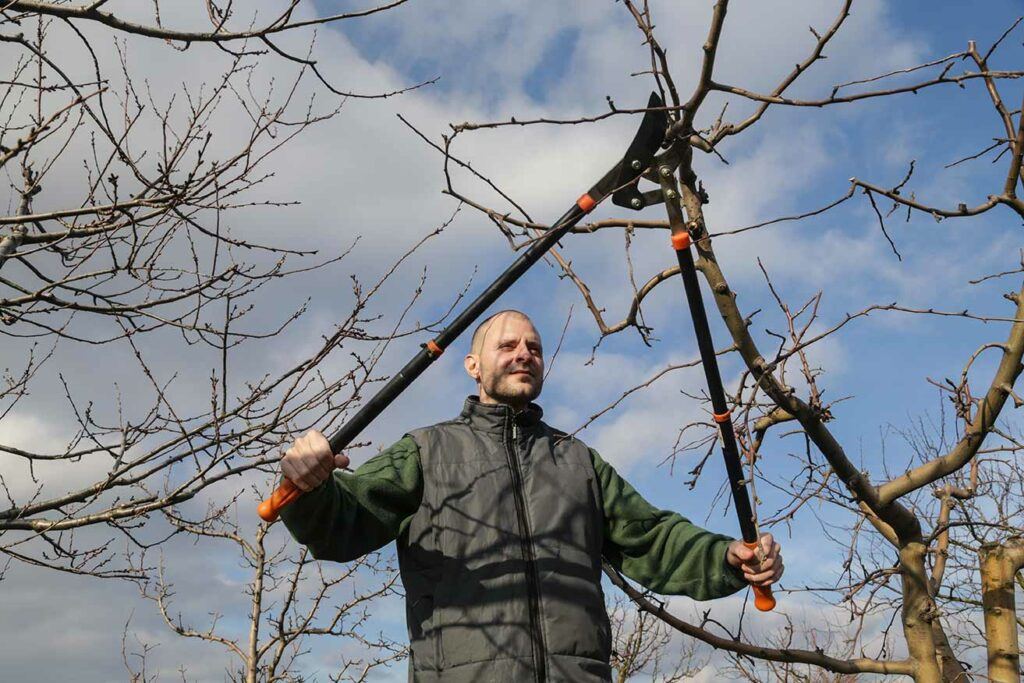It may seem that trees can be forgotten during the colder months, especially when they require less water and get ample rain, but tree pruning in winter, while the trees are dormant, can be a very important tree care practice, depending on your objectives.
In this article, you will be guided through our winter pruning tips, which include how, when, and why to prune your trees.
Trimming vs Pruning
While tree trimming and tree pruning both remove growth from a living tree, they are different, and serve different purposes.
Tree Trimming: Trimming removes healthy growth for shaping and aesthetic, or maybe thinning the interior to let a little more light in.
Tree Pruning: With pruning, dead, damaged, or diseased limbs are cut back or removed to preserve the health of the tree. Pruning generally applies to a more selective method of branch removal or reduction to achieve a determined objective.
Why Pruning is Important
Regular and proper pruning is a vital component to tree care. With this one task, you can help the tree, beautify your property, reduce fire risk, decrease the risk of infestation and disease, and reduce the risk of failure.
With a course correction of the tree’s shape and structure through pruning, you can enhance the tree’s beauty, and correct the balance, to help prevent breakage, especially in a fruit tree. In addition, thinning out the branches in the tree’s canopy can address constricting, overlapping branches.
3 Tips to Winter Tree Pruning
While proper winter tree pruning supports the health of a tree, improper or over-pruning can cause damage. Follow these three tips for successful pruning:
1. When to Prune Trees
If you’re wondering when is the best time to prune trees in California, the simple answer is almost anytime. In certain circumstances, pruning trees while they’re dormant causes much less stress to the tree and, for deciduous trees, it’s much easier to see and access the limbs without the leaves in your way.
While almost all trees can be pruned at any time, in certain circumstances, timing of care may be a factor. Your arborist can tell you when is the best time to prune each variety of tree on your property.
2. How Often to Prune
While every tree will have different needs, most trees benefit from being pruned every three to five years to help maintain their health and structure. How often you prune depends on the type and age of the tree. It’s best to consult a certified arborist regarding a pruning schedule for your particular trees.
3. How to Prune
Once you start to remove dead branches and shape a tree, it can be easy to get carried away. However, a longer view is best, only removing the smallest amount you possibly can to achieve the desired effect. If your new property has trees that have not been properly pruned in decades, addressing the damage all at once could put the tree at risk.
In such cases, you can bring it a little closer to its proper shape and condition over several pruning cycles. Caution should be taken with the quantity of removal in the crown of a tree, as this is where the bulk of its leaves are located, which it relies on for photosynthesis.
The following are the basics, broken down by the two most common objectives.
Removing branches
If you’re removing an entire limb, you’ll want to cut it several inches from the trunk. Remember, though, that you may have to do it in stages, if the tree is large, in order not to introduce undue stress.
You will need to make three cuts for each limb you remove as follows:
- Approximately 12 inches from the branch collar, saw about one-third in from the underside of the limb.
- Position your saw about an inch further out, on the top of the branch, and saw downward until the branch falls.
- Now that you don’t have the weight off the limb torquing on it, you can make a clean downward cut between the sawed end and the branch collar.
This method ensures that the cut is as clean as possible, leaving the surrounding bark and branch collar intact.
Thinning and Shaping
When addressing the smaller branches to encourage new growth and shape the tree, you’ll need loppers or pruning shears, depending on the circumference of the limb. Make a cut at a 45-degree angle just past a healthy growth bud or the junction where the branch meets a larger one. Leave a terminus tip about 1/4 inch above the bud and make the bottom of the cut nearly even with the bud.
Trust Your Trees to Vintage Tree Care for Pruning and More
Pruning a tree for the first time might be a bit intimidating. Especially, knowing that over-pruning or incorrect pruning can damage the tree. If you would like to trust this important task to a professional, the certified arborists at Vintage Tree Care have been providing expert tree pruning services to home and business owners in Sonoma County for over 25 years. Our goal is to help the trees on your property remain healthy and beautiful, and lower the risks of possible wildfires or damage from fallen trees around our community.
Contact our team online to request an estimate for our professional and personalized arborist services, or give us a call at (707) 495-4686 today.
The comments are closed.



No comments yet